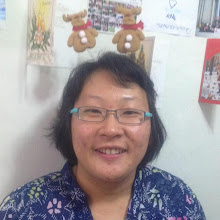1.why modify and how to modify existing learning environment validated instruments;
2. examining a conference paper on items modified;
3. case study analysis by different groups based on School Climate Environment Questionnaire (SLCEQ) on whether the schools are effectiveness
4. APERA conference paper on how Marsiling Sec Sch's D&T Dept. created different learning environments to engage their pupils.
Reflection 1: I agree that various validated instruments have to be carefully considered before surveying on the respondents. The target audience's age, language ability and contextual situation are important factors to determine whether the instrument is suitable. Moreover, since validated instruments have been iterated, if there is a need to administer a survey, we could have considered the various instruments and choose one which is suitable. Modifying and customising the items would enable the results to be useful for further investigate and follow-up actions.
2. In the paper 'Validation of An instrument to Monitor My Students' Face-toFace Philosophy 'Communities of Iniquity' by Yip Meng Fai and Quek Choon Lang, the development and validation of a modified version of the Constructivist Learning Environment Survey (CLES) was done. The data analysis generally supported each scale's factor structure, alpha reliability, discriminant validity and ability to differentiate between classrooms. Discussion surrounded the modifications of a couple of items and the dropping of two scales and the addition of a 'Response' scale adapted from the scale of "Web-based Learning Environment Instrument' (WBLEI) (Chang & Fraser, 2003).
Reflection 2: I can see the relevance of modifying the instrument from this particular research paper. Selected wording and Scales were changed and removed in the context (In an Asian environment). It is clearly seen that modification was needed from the original Classroom Learning Environment Survey (CLES). From this paper, I learned that close examinable of each validated instrument is essential to use it for the right purpose and to obtain accurate and useful results.
3. Effectiveness of three anonymous schools (two are value-added schools) have been discussed. The basis of discussion was mainly based on the School Climate Environment Learning Questionnaire. The questionnaire consists of nine dimensions namely Student support, Affiliation, Professional Development, Achievement orientation, Staff freedom, Participatory decision making, Innovation resource adequacy and Work pressure.
Conducive areas:-
- good discipline in students
- good collegiality among staff
- strong leadership
- considerable structure
- emphasis on balanced development of students
- high commitment level of teachers
- opportunities for staff freedom and participatory decision-making
Non-conducive areas:-
- heavy workload
- high work pressure
- poor academic quality of students
- lack of motivations of students
- not enough autonomy for teachers
- over emphasis on academic achievement
- too much government initiatives
In the three schools discussed, all have areas which are conducive and non-conducive.
Reflection 3: The case studies have detailed write-ups on the school culture and climate and transcripts from interviews with teachers and HODs. For such a survey, the importance of quantitative and qualitative results is clear. Perceptions of the teachers shaped the results of the survey. From my own experience, schools with strong discipline culture tend to do well academically. Therefore, the School Excellence Model (SEM) is a platform for schools to self-examine the processes in place and to focus on the strength and weakness and to work to improve the processes. The learning environment is important for the student to grow up holistically and for the teachers to be more professional in their outlook. Schools need to be more outward looking and be ready to embrace the new changes happening around. Being adaptable and resilient to changes which help the student to thrive in the rapidly changing environment. Hence, the role of a teacher and the school is to create a learning environment for every child to learn at his/her own pace and to become the best that they can be.
4. Learning Environments created by the D&T department were shown in the Problem-Based Learning (PBL) Approach, Knowledge-based Community (KC) and the redesign of the new D&T workrooms(integrated with computers and workbenches). Scaffolding in the KC helped to provide the support in terms of questions that students can post to each other.
Reflection 4: After the rich sharing, I learned that changes can be made if one people starts and move a small group to be committed to the course of action. The areas of PBLs and KCs have been around for a while. However, the implementation across schools seems to be in a more 'ad-hoc' basis. In spending the time to draft and refine the processes, the benefits of creating newer form of learning environment are important. I have experienced the joy and excitement that the presenters brought with them as they present the higher level of engagement in the students who have gone through the PBL and KC journeys.
Link to PBL: http://en.wikipedia.org/wiki/Problem_Based_Learning
Link to KC: http://en.wikipedia.org/wiki/Knowledge_community
Online Discussion Article : http://www.ascilite.org.au/ajet/ajet24/cheong.pdf


No comments:
Post a Comment